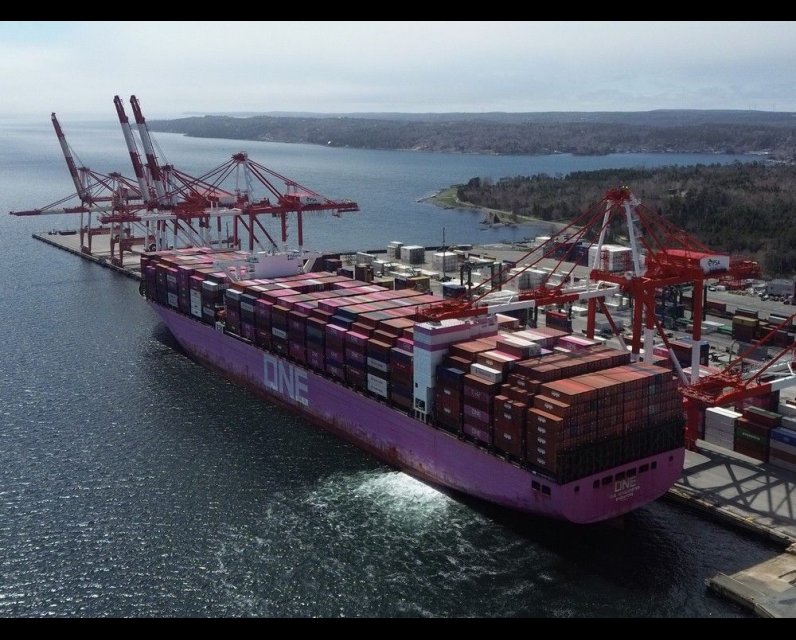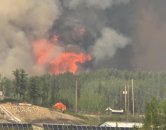Source Feed: National Post
Author: Chris Lambie
Publication Date: May 8, 2025 - 06:30
Navigating 'uncharted’ waters: What Trump's trade war could mean for Canadian ports
May 8, 2025

U.S. President Donald Trump’s trade war is already having an impact on Canada’s most crucial ports, but navigating the on-again, off-again nature of Trump’s words and deeds when it comes to tariffs will likely prove difficult.
Halifax’s container traffic was down 10 per cent last month, while Vancouver was greeting a near record number of oil tankers.
“We’re in uncharted territory,” said Trevor Heaver, professor emeritus of transportation studies at the University of British Columbia.
Like much of the Canadian economy, ports on both sides of the country are bracing themselves for a world in a trade war.
After implementing sweeping 25 per cent tariffs on all goods imported from Canada and Mexico in early March, with a lesser 10 per cent tariff on Canadian energy products, Trump turned around the next day and granted a one-month exemption for automobiles and parts imported from Canada and Mexico that are covered under the Canada-United States-Mexico Agreement (CUSMA). The day after that, Trump broadened the exemption to include all products covered under CUSMA.
There have been plenty of ins and outs since, with Trump slapping 25 per cent tariffs on Canadian steel and aluminum imports and issuing executive orders stipulating that exemptions will continue for goods from Canada and Mexico that are compliant under CUSMA as part of his bigger April 2 “Liberation Day” announcement with that long list of country-specific tariffs.
But last month, after stock and bond markets tumbled, Trump pressed pause for 90 days on tariffs for all countries, except China, resetting the tariff rate to 10 per cent across the board.
Here’s how those involved see the state of play and what may come next.
Can we expect to see less ships calling on Canadian ports due to Trump’s tariffs?
For Heaver, an expert in international shipping and port economics, the answer is a resounding yes. “And it will be dramatic,” he said.
How will that play out?
Heaver predicts the number of what are dubbed “blank sailings” will rise as Trump’s tariffs begin to bite. Those are trips that are scheduled, but then cancelled for want of demand.
Which Canadian coast will this trade war hurt most?
“The worst affected group by the tariff situation is the Trans-Pacific trade,” Heaver said.
“The consequences are that port employment is going to be down, truck employment is going to be down, warehouse employment is going to be down, store shelves are going to start to be more empty, where they’ve been selling Chinese products. So, the drop off in container vessel arrivals is the first visible sign of the tariff threat. Of course, if that threat comes into reality, the recession will take off.”
Which West Coast port will be hit the hardest?
U.S. tariffs will hurt Prince Rupert, Heaver predicted.
“On the Great Circle Route from Asia to North America, it’s the shortest route. So, if you want to import into Chicago, for example, routing through Prince Rupert gives a significant time advantage,” Heaver said. “So, the Port of Prince Rupert will be most affected. The Port of Vancouver less so.”
If fewer ships visit Canuck ports, will they be carrying more or less cargo?
Heaver is forecasting fewer sailings into Vancouver due to the trade war. “But those ships, likely, will each be carrying more cargo for Canada than they would normally,” he said.
What do the folks at the Port of Prince Rupert have to say?
“In April, there were two blank sailings at the Port of Prince Rupert, however those were not attributed to tariffs, but rather the number of vessels operating on an intermodal service string,” said Olivia Mowatt, who speaks for the Port of Prince Rupert.
She said first quarter volumes at Prince Rupert’s Fairview terminal “remained steady,” with a one per cent traffic increase in the first quarter. But officials do expect a downturn.
“Looking ahead, we anticipate decreased container bookings on eastbound transpacific vessels calling on West Coast ports in Canada and the U.S., including potential for blank sailings in Prince Rupert,” Mowatt said.
Do all Canadian ports do a lot of cargo business with our southern neighbours?
More than 80 per cent of the international trade that moves through the Port of Vancouver’s terminals every year is Canadian trade with countries other than the U.S., said Alex Munro, who speaks for the port.
“For example almost 132 million metric tonnes of international trade moved through the port last year, about three-quarters of which was trade with Indo-Pacific countries like China (35 per cent), Japan (14 per cent), Korea (14 per cent), India (five per cent), Indonesia (three per cent), Taiwan (two per cent) and Vietnam (two per cent),” Munro said. “The U.S. represented eight per cent.”
What do ships carry from Vancouver to the States?
Most Canada-U.S. trade through Vancouver is crude oil exports, Munro said.
How are those doing?
Shipments of crude oil, carried from Alberta to B.C. via the Trans Mountain pipeline, did not drop in April, according to retired Simon Fraser University physics professor David Huntley, who has kept tabs for the last 15 years on tanker arrivals at the city’s Westridge terminal.
He counted a record 30 tankers in March that arrived in Vancouver to take Alberta oil to the U.S. and China.
“April tanker traffic was essentially the same as March when you allow that April has one fewer days,” Huntley said.
Do Canadian potash producers need to worry about this trade war?
“The U.S. is one of the world’s largest consumers of potash, but due to a lack of resources in the country, it relies on imports for over 90 per cent of its needs,” said Michael Wudonig, who speaks for K+S Group, one of the world’s largest producers of the fertilizer.
He pointed to Trump’s executive order early last month that exempted potash from U.S. tariffs.
“Deliveries from Canada and the EU are therefore not affected by tariffs,” Wudonig said. “We therefore assess the risk of a change in the exemption for our fertilizer products as low and currently do not foresee any impact on our business.”
How does the Port of Montreal factor into all this?
“Difficult winter conditions challenged most of the North East’s supply chains in January and February, and the Port of Montreal’s cargo was directly and indirectly affected by these conditions,” said Renée Larouche, who speaks for the Port of Montreal.
“March surged back with a very strong showing due to a combination of more normal weather conditions as well as some Midwest businesses looking to stock up ahead of the imminent application of the tariffs announced. We’re carefully optimistic about the next few months and will be ready to support Canadian and American supply chains as they adapt to the new economic realities.”
How is the trade war playing out in Halifax?
Cargo volumes at Halifax’s two container terminals dropped by between eight and 10 per cent in April compared to the previous month, says the company that owns them.
But Trump’s tariff turbulence isn’t all to blame, according to Jonathan Chia, deputy managing director of PSA Halifax.
“I wouldn’t say it’s directly related,” Chia said.
A lot of vessels that stop in Halifax also call on ports along the U.S. Eastern Seaboard, he said, noting those ships have limited space to carry containers.
“They’re actually prioritizing more U.S. cargo rather than imports into Canada,” Chia said.
He saw a reduction last month in the amount of cargo offloaded in Halifax that was bound for Chicago and Detroit by rail. Much of it is heavy machinery and automotive parts including tires and bumpers.
Will things get worse for the Port of Halifax as this wears on?
Chia doesn’t believe Trump’s tariffs are going to make the situation much worse for Halifax than the dip he saw last month.
“I wouldn’t anticipate a significant decrease,” he said, “unlike Prince Rupert, for example, where a big portion of their cargo goes to the U.S.”
How much cargo flows from Halifax into the U.S. by rail?
Between 15 and 20 per cent of the containers that come into Halifax by ship move on to inland destinations in the States, Chia said.
Due to bluster from south of the border, he predicted PSA Halifax could lose much of that traffic.
Why move goods from a ship to a train in Canada if they’re heading to the U.S.?
“The reason they run Midwest cargo through Canada, generally, is it’s generally faster than dealing with the bigger ports in the U.S.,” said Kevin Piper, president of the Halifax Longshoremen’s Association.
“New York is an extremely busy port. So, they come to Halifax for time-sensitive cargo. Because generally cargo can be discharged in Halifax, on the rail and on its way to its destination before the ship ever gets to New York.”
Are Halifax’s 700 longshoremen worried for their livelihoods?
“It’s a wait-and-see-game here,” Piper said.
“We don’t want to stir the pot.”
Where do most of the goods shipped into Halifax go?
Canadian cities like Toronto and Montreal, Chia said.
“We might lose some of the U.S. Midwest volumes, but … we don’t move them that much to begin with.”
Does the state of the economy make him anxious about the country’s future?
“I do see Canada moving toward a recessionary situation and when you go into a recession it basically means people are producing less and people are consuming less,” Chia said.
That means a drop in cargo volumes, he said. “That’s my bigger fear rather than just a trade war. It’s triggering a bigger global economic impact,” Chia said. “Jobs will be lost and consumption will drop … we’re probably heading in that direction.”
As tariff talk changes almost daily, “people are not committing to ordering,” he said. “They’re being more cautious in their buying patterns and manufacturing and production. This definitely will cause the economy to slow down. Unless there’s certainty in what’s going to happen in the next 12 months, generally people will become more cautious. That’s my bigger fear — it’s the uncertainty that kills the demand.”
What advantages to shipping goods through Canada are vanishing?
Chia pointed out that Trump recently closed a loophole where goods landed in Canada and transported by rail into the States didn’t have to pay a harbour maintenance tax of 0.125 per cent.
“They actually extended this tax on to any U.S. cargo coming through Canadian ports,” Chia said.
Does he see any bright spots for Canadian ports on the distant horizon?
“With the U.S. being more reclusive, it’s forcing Canada to trade with other partners, whether it’s Europe or Asia. But … supply chains don’t switch overnight,” Chia said.
“I do see in the medium- to longer run a more robust Canadian supply chain sourcing from more alternative locations instead of just the U.S.”
How is this playing out in the U.S.?
Bonded warehouses on the U.S. West Coast where goods can be stored without paying tariffs “maxed out very, very quickly, within like a week or two in anticipation of all of this,” said Ken Adamo, a shipping analyst with DAT Freight & Analytics in Akron, Ohio.
Could vessels destined for the U.S. head to Canada instead?
While some ships that call on the U.S. West Coast could instead steam to Canada, their goods would still face tariffs if shippers tried to get them into the States by train or truck, Adamo said.
“There’s a pretty big wrinkle that was introduced” last week, he said. “An executive order came down around English language proficiency for truck drivers operating in America. The problem with that being … that a lot of the Canadian cross-border truck drivers (come from a) largely immigrant-fed pipeline of drivers.”
English proficiency could prove difficult to test “in a standardized way that would hold muster in a court of law,” he said, noting truckers who fail can be put out-of-service on the roadside.
How is this affecting the mindset of those in the business of getting your goods to market?
“This administration has made it very difficult to find any sort of continuity or consistency,” Adamo said. “Shippers and trucking companies alike are very confused and, frankly, very, very anxious on how to approach the shifting landscape of regulation and global trade policy.”
Is there any potential end in sight to the trade war?
Adamo sees a “hard terminus for a lot of this” in the U.S. back-to-school season.
“I know it sounds crazy because the kids are still in school right now. But in logistics, we’re thinking way upstream of all the school supplies and this year’s school clothes and kids’ shoes. All of that stuff is going to probably land May, June and July to be on the store shelves when people do all their back-to-school shopping.”
Americans looking for deals on pencils and lunch boxes might end up dictating U.S. trade policy, he said. “I don’t think the American consumer is going to tolerate empty shelves for back-to-school.”
What’s Trump’s endgame here?
Adamo had to read Trump’s book, The Art of the Deal, in business school. “The tactic is you start with a completely outlandish and overexaggerated position and then help negotiate your opponent back to centre,” he said. “So, my guess is I think most Asian trading partners will get deals done.”
Our website is the place for the latest breaking news, exclusive scoops, longreads and provocative commentary. Please bookmark nationalpost.com and sign up for our daily newsletter, Posted, here.
The Saskatchewan Public Safety Agency will hold a live update on the province's wildfire situation at 1:30 p.m. Thursday in Prince Albert.
June 6, 2025 - 13:56 | Mackenzie Mazankowski | Global News - Canada
The federal Department of Justice is set to lay off up to 264 employees as it navigates what it calls “significant budgetary pressures.”Ian McLeod, a spokesperson for the department, says in an email that the department is taking “difficult but necessary” steps to manage available resources, given ongoing budget pressures that “can no longer be sustained.”
June 6, 2025 - 13:52 | Catherine Morrison | The Globe and Mail
The province’s police watchdog has cleared Hamilton police officers of wrongdoing in connection with the fatal shooting of Erixon Kabera on Nov. 9, 2024.
June 6, 2025 - 13:40 | Kevin Nielsen | Global News - Ottawa



Comments
Be the first to comment